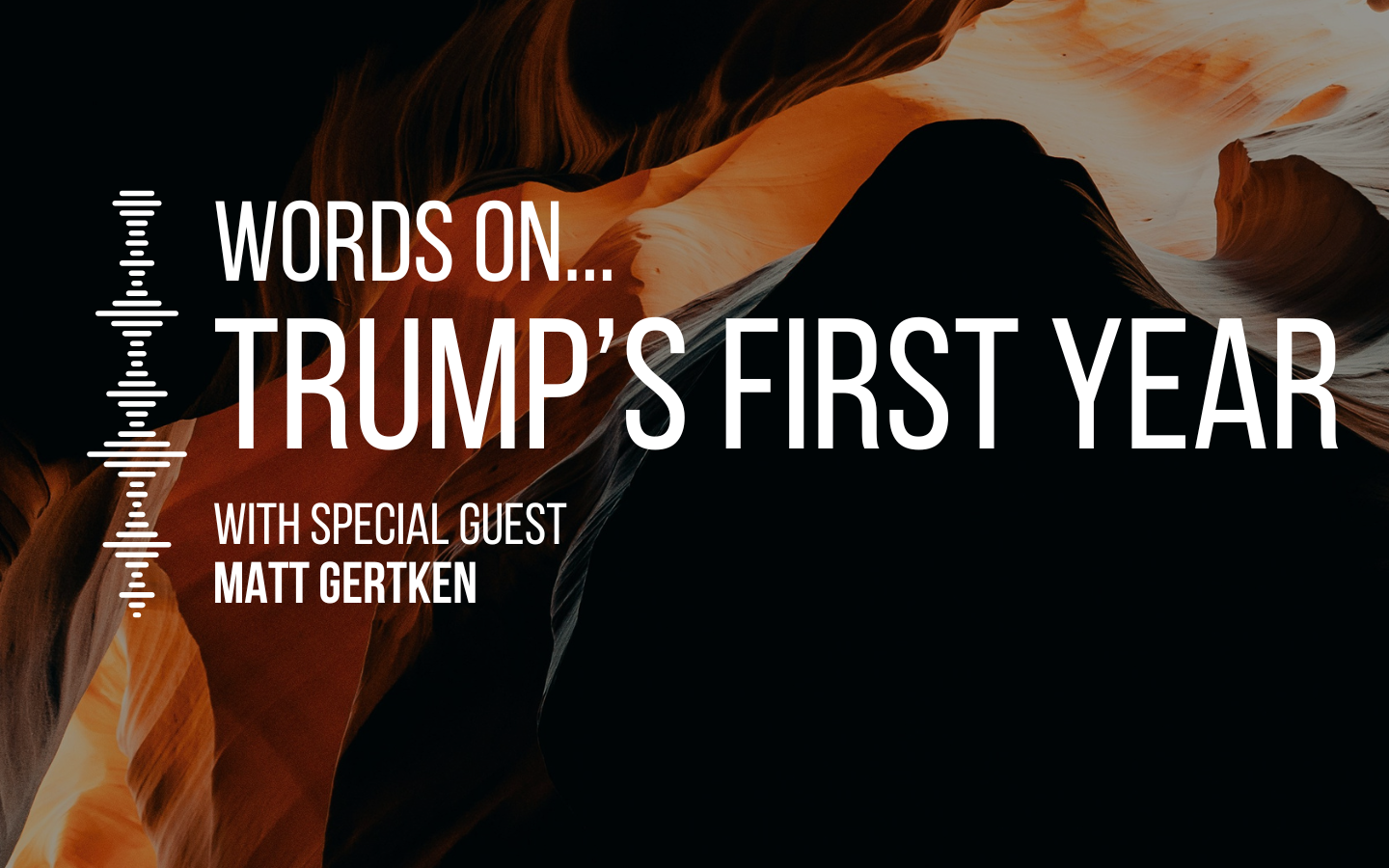


In this episode of Words on Wealth, Tim Rocks, CIO at Evans & Partners, sits down with Julian Evans-Pritchard, Head of China Economics at Capital Economics, to explore the fast-evolving dynamics of US-China trade relations. Amid news of upcoming trade negotiations, the conversation unpacks the likely scenarios around tariffs and what both nations might realistically offer in talks. Julian outlines China’s potential concessions, while highlighting the deep misalignment between US and Chinese strategic goals, which may limit the scope of any deal. Tune in to find out more.
This episode is also available on Apple Podcast.
Tim Rocks
Hello and welcome to Words on Wealth. I’m Tim Rocks, Chief Investment Officer at Evans & Partners. I’m delighted today to be joined by Julian Evans Pritchard, who is Head of China Economics at Capital Economics, which is one of the consultancies we use to help us with our investment decisions. Obviously a lot going on in the world of US and China relations. So we’ll get into that today. And I should just preface this with we’re recording this on Wednesday, the 7th of May. And actually, there’s just been announcement of trade negotiations that will occur later in the week. So obviously, we don’t know what’s going to go on there. But just just, you know, just as a reminder that everything is moving very, very quickly at the moment. Anyway, but look, thank you very much for joining us, Julian.
Julian Evans Pritchard
Yeah, thanks for having me.
Tim Rocks
So why don’t we start with that whole tariff issue, which is obviously the main topic in the world at the moment. And again, we don’t know what’s going to happen later on this week, but do you want to give us some context about how you think these tariffs might play out? What do you think a deal looks like? What can China offer? Love to hear your thoughts.
Julian Evans Pritchard
First of all, I’m glad you prefaced this with when we’re recording it, because as you say, things are changing so quickly. So what I say now may not be entirely up to date in a day or two’s time. But what we know at the moment is, as you say, the US and China have finally agreed to start formal talks. It’s going to be between Scott Besson, US Treasury Secretary, and He Li-Feng, who’s the vice premier in China, who’s sort of in charge of economic policy, in particular trade policy. So finally, we have two senior members of both sides meeting and talking through the tariff issue. I think just to set some expectations, we had some comments from the Ministry of Commerce over the past day or so, of trying to basically make it clear that yes, China is agreeing to these talks, but they expect the US to show sort mutual respect to correct some of their mistakes, reverse the tariffs. So, you know, I think clearly it’s not guaranteed that these negotiations will necessarily lead to a positive outcome. That said, I do think that there’s enough that both sides can potentially, enough common ground that we can potentially get some kind of de-escalation. I think in terms of what China will be willing to offer, I think they’ll be happy to roll back some of the retaliatory tariffs that they put on the US in exchange for the US doing the same. So both sides bringing down some of those tariffs.
Tim Rocks
Yeah, that’s sort of the easy win, isn’t it? Yeah.
Julian Evans Pritchard
Yeah, that’s the easy win. Otherwise, I think they’d probably be willing to offer some concessions around fentanyl. That was, of course, the justification for the first two rounds of Trump tariffs on China during the current administration. So 10 % in February, then another 10 % in March. Clearly, that is an issue that China could do more to prevent these precursor chemicals from flowing into the US. there was a Wall Street Journal and a New York Times story suggesting that China is considering making concessions in that regard. I think the Chinese would also be willing to offer to increase their purchases of certain US goods. I guess the interesting question is whether the US will be happy to sell them the goods that they want. Obviously, they want to buy things like high-end semiconductors, which the US has imposed export controls and –
Tim Rocks
That’s right, the US will want them to buy soybeans and they’re going to want to buy semiconductors.
Julian Evans Pritchard
Yeah, exactly. So there’s a bit of an issue there. But I think, you know, potentially, certainly for agricultural goods and energy as well. There’s potential for China to offer some kind of purchases. But I think that’s kind of where it ends really, in terms of what China is willing to offer, probably, I don’t think they’re really willing to offer a substantial concessions in terms of domestic policy reforms, or really commit to any specific exchange rate targets, for example. I think they want to avoid giving the perception that the US is setting their own domestic economic policy. And I think they’re also very skeptical about the US’s ability to stick to these commitments. so there’s clearly, there’s the economic side, of course, they want to minimize the damage, but there’s also the political consideration, where you agree to do the deal with the US. And in a few months time, the US simply reneges on that deal and you end up with egg on your face. So I think clearly they’re going to want to avoid that kind of situation. so they’re probably only going to be willing to offer something that’s relatively costless for them to offer. So that if things go south in a few months time, they haven’t really lost out that much.
Tim Rocks
Yeah, which doesn’t feel like it’s going to be enough for the US because it seems most well, at least one part of this whole tariff scenario scenario is that the US is seeing China as this existential threat and genuinely wants to either inflict damage or materially reduce exports. And clearly that’s not something that China is going to, you know, concede to. So surely the two sides can’t really make major agreement on the two on this issue because they’re just so far apart with their aims and what they’re actually want to get out of this.
Julian Evans Pritchard
Yeah, I agree. And I think there are lots of differing views within the Trump administration on this. think clearly you have the more hawkish individuals who would be quite happy to see an almost complete decoupling in trade between the US and China. But then you have people who would prefer maybe a of a moderate form of decoupling. I think Scott Vesson probably falls under that category. And I think Trump himself is sort of not entirely committed to the decoupling clause. He sort of swings between the two. in recent weeks, at least, sort of leaning more towards the view that tariffs on China need to come down, there needs to be some kind of deal. So I think the calculation in China will be that, okay, yes, it’s going to be hard to reach some kind of substantive deal with the US. But Trump seems to want to reduce tariffs. so maybe there’s they can offer some minor concessions and it will be a way for Trump to of row back some of the tariffs without losing too much face, be able to claim that he got something in return. And that basically we end up back to where we were a few weeks ago. So our base case is that tariffs come back down, but not entirely. So sort of a half house where we get tariffs on China, maybe around 60%. They’re currently around 110%. So that would be a substantial reversal. I don’t, you know, I think you’re right. I don’t think this is going to be entirely resolved. And I don’t think we’re going to get back to the tariff rates that we were at at the start of the year.
Tim Rocks
Yeah, yeah. Okay, well, let’s move on and take that base case of yours and then talk about what that means for the economy. You know, can China withstand that? What are the measures it puts in place to mitigate the damage? And you know, can they still achieve their say, four to 5 % growth rate in that backdrop? Or with that backdrop?
Julian Evans Pritchard
Yeah, so think many people are actually overestimating the extent of the damage that the US tariffs will do. That’s for a few reasons. One reason is that I guess many people are taking the current tariff rates as the baseline, which I’m hopeful that that won’t be the case and the tariff rates will come down. But the other two factors, I think that there’s substantial offsets to these tariffs. We’re already seeing in the exchange rate, for example, you wouldn’t notice it if you look at the renminbi versus the dollar because obviously the dollar has been weakening. But if you look at the renminbi in trade weighted terms, it’s already weakened 4 % since Liberation Day. And of course, the exchange rate applies not just to the goods that are going to the US, but China’s entire export basket. So you can get a decent offset from the exchange rate. And also, I think it’s just the lesson from the first trade war is that it’s very easy for trade and supply chains to simply reorientate themselves to avoid tariffs. And we’re already starting to see that in the data. We’ve got the Vietnamese trade data for April yesterday that showed a very large jump in imports from China and a very large jump in exports to the US.
Tim Rocks
Surprise, surprise.
Julian Evans Pritchard
And if you know, we’ve done some work on this, our estimates suggest that during the first trade war, around half of the decline in China’s, the share of Chinese exports going to the US can just be explained through rerouting. Of course, this time the incentives for rerouting are going to be even more substantial. Of course, that depends a bit on where US tariff rates on other countries end up. But our assumption is that most countries will be able to make some kind of deal with the US to prevent substantial tariffs.
Tim Rocks
Yeah, yeah. So there’s some country in the regions that’s got a much less tariff of 10 % if it’s Malaysia or Thailand or whatever, they’ll just the rerouting could very quickly change to the lowest point.
Julian Evans Pritchard
Yeah, exactly. I think the US would have to convince pretty much all neighboring countries to impose their own tariffs on China in order to prevent this kind of thing from happening. And I don’t get the impression that the US is having much success convincing other countries to take those kind of measures. So I think that leaves us in a position where, yes, you may well get a substantial decline in Chinese exports to the US, but China’s overall export performance may not be hit as much as people expect. under our base case of a 60 % tariff with those offsets from the exchange rate and rerouting, we think the hits to GDP will be less than 0.5%. So, you pretty manageable, certainly something that could be offset through policy stimulus. Having said that, you know, I think the US tariffs are just one headwind facing China’s export sector. And I don’t think that is actually the main challenge facing the export sector. I think the biggest challenge is that we’ve gone through this period post pandemic where Chinese exports have been booming. Export volumes last year rose 13%. That level of export growth, even without US tariffs is simply not sustainable.
Tim Rocks
Yeah.
Julian Evans Pritchard
A lot of it was driven by this one off effect of the pandemic, which basically pushed up inflation, pushed up price levels outside of China, but didn’t push them up inside of China. And the lag, the lagged effect of that sort of gain and competitiveness because of the pandemic has been boosting exports, but that’s a one off effect.
Tim Rocks
Isn’t part of that also would have been this massive increase in Chinese auto and battery exports, those types of things. Isn’t part of that sustainable?
Julian Evans Pritchard
That’s definitely part of the story and Chinese industrial policy has played a role. But you look at China’s gains in global export market share, they’re actually pretty much across the board, not only in those high tech products that are being targeted by industrial policy, but all kinds of low end products as well, even things like textiles, toys, furniture, et cetera. there’s been a broader phenomenon here, which I think comes largely down to the pandemic and the very different effect it had on prices outside of China and inside of China. And I don’t think that driver of export growth is sustainable. So even without US tariffs, you’re probably looking at a substantial slowdown in Chinese export growth over the next couple of years. And to put that into context, exports added two percentage points to Chinese GDP growth last year. Over a third of Chinese GDP growth was coming from exports.
Tim Rocks
Yes.
Julian Evans Pritchard
it’s going to be very hard for China to sustain recent rates of growth, even if US tariffs come down. And I think that’s the fundamental challenge. And that’s why you’re going to need pretty substantial domestic policy support to offset that drag from the export sector, regardless of what happens to tariffs.
Tim Rocks
Yeah. Okay, well, let’s that’s a good segue to talking about what this all might mean for the construction side of the economy, which sitting in Australia is relevant for the implications for iron ore in particular. So do you think there will be meaningful stimulus that will at least hold the level of commodity demand for construction? And I guess part of that is what’s going what you think is going on in the property market as well? What’s your take on all of that?
Julian Evans Pritchard
So the government has announced a decent amount of fiscal stimulus this year already in that budget in March, around a one and a half percent fiscal loosening, we estimate.
Tim Rocks
Okay. And is it sorry, is that all heavy industry? Or is that consumer as well?
Julian Evans Pritchard
That is actually mostly investments. A lot of it is nowadays going into manufacturing, which I guess is less construction intensive. A lot of it is still going into traditional infrastructure investments. So in sort of normal circumstances, 1.5 % of GDP fiscal loosening mostly into infrastructure would definitely boost construction activity. But the problem is we’re not in a kind of normal environment at the moment in China with what’s going on in the property sector. And in the property sector, you’ve obviously already had a very substantial adjustment in terms of new construction activity. So new housing starts have fallen more than 70%. Because there’s a very large backlog of projects that haven’t been completed yet. And the government sort of trying to support these developers to complete these projects. Overall, property investment in real terms has only fallen 20%. So you’ve still got a probably a period of a few years still, where construct property construction is going to be contracting still. Even if sort of new housing demand stabilizes, and we have seen new home sales stabilize over the past few quarters. So there are some kind of signs of positive developments in terms of demand. But I think that the impact of that on construction, will take, because of the backlog and how much overbuilding we’ve had, it’s going to take many years for developers to clear their inventories to finish all these existing projects. So you’re looking at another year, this year of falling property construction activity. And the key question is whether the impulse from infrastructure will be enough to offset the decline from property. And at the moment, it’s not entirely clear. think the two sort of roughly offset each other. think, you know, our forecast suggests that maybe you get a slight increase in construction activity this year, certainly not the kind of boom that we’re used to when China does large scale physical stimulus.
Tim Rocks
Yeah, yeah. Yeah, so that’s right. We’re not expecting like a 2010 kind of scenario. But is it fair to say that this still a determination to get that? Well, they’ll claim it’s 5 % growth, but say 4 % is four to 5 % true growth. So even if exports, and the property side are a little weaker than expected, then they’ll just turn up the volume on infrastructure. So net year that there’s not a big risk of a material fall in overall construction activity.
Julian Evans Pritchard
Yeah, I think overall construction activity probably at least holds steady this year. I would be surprised if it contracts outright. I’m more concerned, to be honest, the manufacturing investment and about the consumer sector. A lot of the strength in investment the past couple of years has come from the manufacturing side. But as we just discussed, I mean, in a world in which you know, export demand kind of weakens. It’s very, hard to sustain these kind of levels of manufacturing investment. It requires the rest of the world to absorb all this additional capacity because domestic consumers are not absorbing it. So yeah, I’m probably more concerned on that front. think the construction side, it will depend a bit on whether we get some additional fiscal support later in the year. I mean, at this stage, amount of fiscal that’s in the budget doesn’t look like it’s enough to me to keep growth above 4%. So if they do want to keep growth above 4%, I think that they will have to announce a mid-year adjustment to the budget. I they did do that back in 2023. I think it’s possible they have the Politburo, the latest Politburo meeting did signal a willingness to make these kind of adjustments. So I think that will be the key thing to watch sort of later in the year, maybe around the July, August time, whether we get any announcement on a sort of mid-year expansion of fiscal support, because without that, I think there are some sort of risks of a substantial slowdown in Chinese growth this year.
Tim Rocks
Yeah, yeah. And then you mentioned briefly the other I mean, the piece that’s been missing from the jigsaw for a long time has been the consumer and a bouncing consumer. I mean, I think we’re probably into our second decade of China trying to simulate consumption and nothing happening. Do you think that’s likely to change anytime soon?
Julian Evans Pritchard
Well, they’re saying the right things. They’ve said that they want their main priority this year to be supporting consumption. The problem is, I think they’re not really backing that up with enough substantive measures. They have expanded the consumer goods trading scheme this year. So last year it was 150 billion yuan, this year it’s 300 billion. There have been some minor tweaks to social security, that kind of thing. A 150 billion yuan increase in these consumer goods subsidies is relatively small change. If you actually look at where most of the additional fiscal support is going to, as I said, it’s mostly still going to investment. Last year, the share of government spending devoted to investment was the highest since the late 1980s. So despite all the talk about trying to support consumption, they’re actually doing the opposite.
Tim Rocks
Yeah.
Julian Evans Pritchard
They’re devoting more more fiscal spending towards investment. And I think it comes back to a few things. One is their view on geopolitics and this sense that, okay, we need to focus on reducing our vulnerabilities and making sure that we’re not relying on the West for key inputs into our manufacturing sector. And as a result, a lot of the focus in recent years, and that’s continuing this year, is to build out those industrial supply chains domestically, which obviously is a sort of more of an investment focus. I think the other issue here is that to sort of genuinely boost consumption growth and rebounce the economy towards consumption, key thing you need to do is bring down the household savings rate, which is still extremely high by global standards. But you can’t really bring down the household savings rate just by providing one-off subsidies because it doesn’t change household savings behavior. You need to make households feel more confident that over the long term, their future healthcare needs will be paid for, their future pension needs will be paid for by the government. So you need a much more generous welfare system. But of course, when the government commits to that, it’s also committing to escalating fiscal costs over the long run. And it’s still a degree of fiscal conservatism in China and this view that the government should not be borrowing to fund current consumption. We should only be borrowing to fund increases in the productive capacity of the economy. And as long as you have that kind of mentality in the government, I think it’s very hard for them to commit to these kind of large scale increases in the social welfare net that you need to bring down the household savings rate.
Tim Rocks
Yeah, yeah, feels like yeah, it’s a very challenging structural kind of issue. Presumably, at some point, the property market is going to start bouncing. And that’s going to be important too. I mean, if those with property feel wealthier, that might matter at the margin. But other than that, I think you’re saying it’s going to be a long term struggle.
Julian Evans Pritchard
Yeah, you’re right. mean, the property market downturn is the other key factor here. The of the negative wealth effects from that are what’s keeping, you one reason that the household savings rate is actually rising because households are saving more to offset the impact of the decline in the value of their homes. So yeah, a key question is when will home prices bottom out? We’ve already had a 10 % decline in new homes values and around a 17 % decline in secondary sort of resale home values. That’s a lot by Chinese standards, but I think potentially you could see falls continue for quite a while. I we’ve seen in other countries often, in some cases, home prices, the peak to trough drawdown of up to 50, 60%. I mean, in Japan, we saw something similar to that. And just the amount of overbuilding that we’ve had in China, means that it probably will still take a while for the market to continue to absorb this over supply and for prices to find a new equilibrium. So we’re not expecting prices to bottom out this year. in that environment, you can’t really get a boom in consumption unless the government steps in and the government’s not stepping into that degree.
Tim Rocks
Yeah, yeah. All right. Well, thanks for all of that, Julian. So it sounds like a kind of summary is that this obviously there’s a lot of uncertainty. There’s many moving parts, but you feel like there’s enough reason to think there’ll be some resilience or at least policy options that will ensure that the overall economic outcomes won’t be all that different from previous years.
Julian Evans Pritchard
Yeah, I think you’re looking at a continuation of the sort gradual slowdown that we’ve seen in recent years. I think there are more downside risks this year, but I do think the government has tools available that it can use to offset that. It’s just a question of willingness to use those tools. So we’ll just have to keep an eye on that.
Tim Rocks
Yeah, excellent. Thank you very much for your time and your insights. They’ve been really interesting, Julian.
Julian Evans Pritchard
Yeah, it’s great to be on the podcast.
Tim Rocks
Okay, thanks a lot. And just a reminder to clients on the call that everything today should be considered as general advice. If you’re after personal advice, please contact an advisor. Thanks and bye.
Tags
Disclaimer
This podcast was prepared by Evans and Partners Pty Limited AFSL 318075.
Any advice is general advice only and was prepared without taking into account your objectives, financial situation or needs. Before acting on any advice, you should consider whether the advice is appropriate to you. Seeking professional personal advice is always highly recommended. Where this presentation refers to a particular financial product, you should obtain a copy of the relevant PDS, TMD or offer document before making any investment decisions. Past performance is not a reliable indicator of future performance.
Directors, employees and officers of Evans and Partners and its related bodies corporate may have holdings in the securities discussed. Any taxation information is general and should only be used as a guide.
This communication is not intended to be a research report (as defined in ASIC Regulatory Guides 79 and 264). Any express or implicit opinion or recommendation about a named or readily identifiable investment product is merely a restatement, summary or extract of another research report that has already been broadly distributed.


